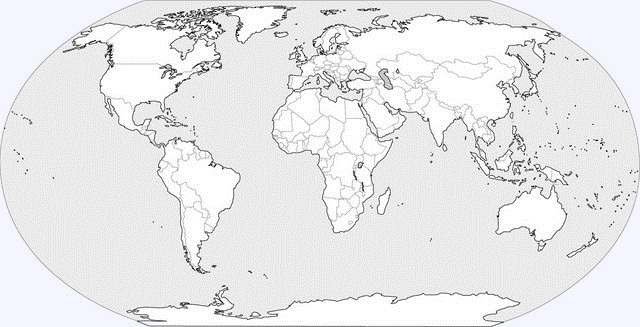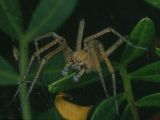|
Nombre común en ingles:
Crab Spiders
Nombre común en castellano:
Se desconoce
Familias similares:
Género tipo:
Thomisus Walckenaer, 1805
Diagnosis:
Small to large araneomorph spiders; two tarsal claws;
ecribellate; entelegyne; eight eyes; legs lateridrade with I and II
usually longer tan III and IV (except Bominae); lateral eyes usually
on tubercles; morphologically a very diverse group.
Caracteres descriptivos: Caparazón:
variable; varies from semicircular, ovoid to elongated; usually with
simple, erect setae; some especies with strong protuberances or eye
tubercles. Esternón:
heart-shaped. Ojos: eight; in two rows (4:4); lateral eyes
usually on tubercles, which vary from rounded to distinct: lateral
eyes usually larger than other eyes. Quelíceros: cheliceral
teeth absent except in Stephanopinae; cusps or small denticles
sometimes on promargin. Piezas bucales: endites and labium
usually longer than wide; greatly elongated and pointed in
Strophiinae. Patas: two claws; laterigrade; legs I and II
longer than III and IV (except Bominae); anterior tarsi without
scopulae; claw tufts absent or, if present, consisting of spatulate
setae; anterior legs frequenly with series of strong spines on
tibiae and metatarsi. Abdomen: variable in shape, from round
to ovoid or elongated, extending caudally beyond spinnerets; usually
with scattered simple setae. Hileras:
anterior spinnerets short, conical and narrowly separated; colulus
present. Sistema respiratorio:
two booklungs; tracheal spiracle close to spinnerets. Genitalia: entelegyne; epigyne
variable, usually with hook; guide pockets or atrium bordered; tibia
of male palp with ventral and retrolateral apophyses; tegulum
disc-like; embolus variable. Tamaño corporal:
2-23 mm. Color: variable, from brightly coloured (pink,
green, yellow) to dark brown or grey and mottled; abdomen frequently
patterned.
Estatus taxonómico:
The ralationships of the Thomisidae are still unclear, Levi (1892)
placed them in a superfamily along with the aphantochilids now
incorporated in the family but Loerboks (1984) found similarities
between the palps of thomisids and salticids. According to
Coddington & Levi (1991), their place in the Dionycha is not clear
and the monophyly of that group has not yet been proven.
Distribución: mundial.

Estilo de vida: Wandering
spiders found mainly on foliage, with only a few genera living on
the ground.
Bibliografía:
-
Dippenaar-Schoeman, A.S. & Jocqué,
R. 1997. African Spiders: An Identification Manual. Plant Protection
Res. Inst. Handbook, no. 9, Pretoria, 392 pp.
-
Dondale, C.D. 2005c.
Thomisidae. pp. 246-247 in Ubick, D., Paquin, P., Cushing, P.E. &
Roth, V. (Eds) 2005. The Spiders of North America. An Identification
Manual. American Arachnological Society.
-
Lehtinen, P.T. 2004.
Taxonomic notes on the Misumeni (Araneae: Thomisidae: Thomisinae),
primarily from the Palaearctic and Oriental regions. European
Aracnology 2003 (Logunov D.V & Penney D. Eds.) Arthropoda Selecta,
special issue: 147-184.
-
Millot, J. 1942 de
l'Afrique Occidentale Français: Thomisidae. Mém. Ac. Sci. Paris (2)
65: 1-82.
-
Ono, H. 1988. A
revisional study of the spider family Thomisidae (Arachnida, Araneae)
of Japan. National Science Museum, Tokyo, 252 pp.
-
Wunderlich, J. 2004.
Fossil spiders in amber and copal. Joerg Wunderlich Verlag.
Hirschberg-Leutershausen (Germany). Vol. 3 A, B, 1908 pp.
16 géneros y 70 especies presentes en la Península Ibérica:
|
| |
- B. versicolor
(Keyserling, 1880) |
|
| |
- C. depressa
(C. L. Koch, 1837) |
|
| |
- C. blackwalli
(Simon, 1875) |
|
| |
- D. dorsata
(Fabricius, 1777) |
| |
- D. livens
Simon, 1876 |
|
| |
- E. tricuspidata
(Fabricius, 1775) |
|
| |
- F. bivittatus
Simon, 1895 |
|
| |
- E. hirtus
(Latreille, 1819) |
| |
- E. melloteei
Simon, 1886 |
| |
- E. setiger
(O. P.-Cambridge, 1872) |
|
| |
- M. vatia
(Clerck, 1758) |
|
| |
- M. paradoxus
(Lucas, 1846) |
|
| |
- O. atomaria
(Panzer, 1801) |
| |
- O. bejarana
Urones, 1998 |
| |
- O. bicuspis
Simon, 1932 |
| |
- O. claveata
(Walckenaer, 1837) |
| |
- O. flava
Simon, 1875 |
| |
- O. furcula
L. Koch, 1882 |
| |
- O. pauxilla
(Simon, 1870) |
| |
- O. perplexa
Simon, 1875 |
| |
- O. praticola
(C. L. Koch, 1837) |
| |
- O. rauda
Simon, 1875 |
| |
- O. scabricula
(Westring, 1851) |
| |
- O. simplex
(O. P.-Cambridge, 1862) |
| |
- O. trux
(Blackwall, 1846) |
| |
- O. umbraculorum
Simon, 1932 |
|
| |
- P. truncatus
(Pallas, 1772) |
|
| |
- R. flavida
(Simon, 1881) |
| |
- R. grammica
(C. L. Koch, 1837) |
|
| |
- S. globosum
(Fabricius, 1775) |
|
| |
- T. citrinellus
Simon, 1875 |
| |
- T. onustus
Walckenaer, 1805 |
|
| |
- T. piger
(Walckenaer, 1802) |
| |
- T. piochardi
(Simon, 1866) |
| |
- T. punctatissimus
(Simon, 1870) |
| |
- T. staintoni
(O. P.-Cambridge, 1873) |
| |
- T. stellio
Simon, 1875 |
|
| |
- X. acerbus
Thorell, 1872 |
| |
- X. audax
(Schrank, 1803) |
| |
- X. bifasciatus
C. L. Koch, 1837 |
| |
- X. bliteus
(Simon, 1875) |
| |
- X. bonneti
Denis, 1938 |
| |
- X. bufo
(Dufour, 1820) |
| |
- X. caperatus
Simon, 1875 |
| |
- X. cor
Canestrini, 1873 |
| |
- X. cribratus
Simon, 1885 |
| |
- X. cristatus
(Clerck, 1757) |
| |
- X. desidiosus
Simon, 1875 |
| |
- X. erraticus
(Blackwall, 1834) |
| |
- X. ferrugineus
Menge, 1876 |
| |
- X. fienae
(Jocqué, 1993) |
| |
- X. gallicus
Simon, 1875 |
| |
- X. grallator
Simon, 1932 |
| |
- X. ibex
Simon, 1875 |
| |
- X. kempelini
Thorell, 1872 |
| |
- X. kochi
Thorell, 1872 |
| |
- X. lalandei
(Audouin, 1826) |
| |
- X. lineatus
(Westring, 1851) |
| |
- X. luctuosus
(Blackwall, 1836) |
| |
- X. nigrotrivittatus
(Simon, 1870) |
| |
- X. ninnii
Thorell, 1872 |
| |
- X. nubilus
Simon, 1875 |
| |
- X. ovatus
Simon, 1876 |
| |
- X. parallelus
Simon, 1873 |
| |
- X. robustus
(Hahn, 1832) |
| |
- X. sabulosus
(Hahn, 1832) |
| |
- X. semicarinatus
Simon, 1932 |
| |
- X. striatipes
L. Koch, 1870 |
| |
- X. tortuosus
Simon, 1932 |
| |
- X. ulmi
(Hahn, 1831) |
| |
|
 |